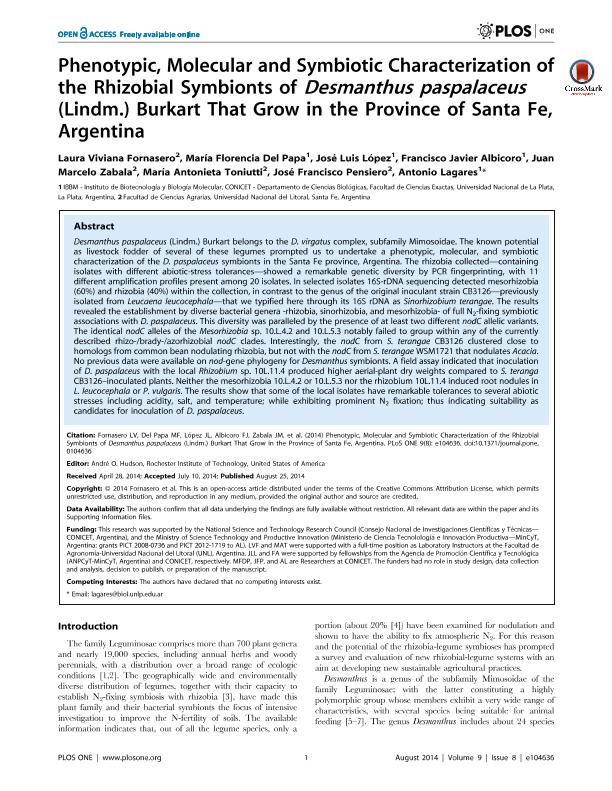Artículo
Phenotypic, Molecular and Symbiotic Characterization of the Rhizobial Symbionts of Desmanthus paspalaceus (Lindm.) Burkart That Grow in the Province of Santa Fe, Argentina
Fornasero, Laura Viviana; del Papa, Maria Florencia ; López, José Luis
; López, José Luis ; Albicoro, Francisco Javier
; Albicoro, Francisco Javier ; Zabala, Juan Marcelo; Toniutti, Maria Antonieta; Pensiero, Jose Francisco
; Zabala, Juan Marcelo; Toniutti, Maria Antonieta; Pensiero, Jose Francisco ; Lagares, Antonio
; Lagares, Antonio
 ; López, José Luis
; López, José Luis ; Albicoro, Francisco Javier
; Albicoro, Francisco Javier ; Zabala, Juan Marcelo; Toniutti, Maria Antonieta; Pensiero, Jose Francisco
; Zabala, Juan Marcelo; Toniutti, Maria Antonieta; Pensiero, Jose Francisco ; Lagares, Antonio
; Lagares, Antonio
Fecha de publicación:
08/2014
Editorial:
Public Library of Science
Revista:
Plos One
ISSN:
1932-6203
Idioma:
Inglés
Tipo de recurso:
Artículo publicado
Clasificación temática:
Resumen
Desmanthus paspalaceus (Lindm.) Burkart belongs to the D. virgatus complex, subfamily Mimosoidae. The known potential as livestock fodder of several of these legumes prompted us to undertake a phenotypic, molecular, and symbiotic characterization of the D. paspalaceus symbionts in the Santa Fe province, Argentina. The rhizobia collected—containing isolates with different abiotic-stress tolerances—showed a remarkable genetic diversity by PCR fingerprinting, with 11 different amplification profiles present among 20 isolates. In selected isolates 16S-rDNA sequencing detected mesorhizobia (60%) and rhizobia (40%) within the collection, in contrast to the genus of the original inoculant strain CB3126—previously isolated from Leucaena leucocephala—that we typified here through its 16S rDNA as Sinorhizobium terangae. The results revealed the establishment by diverse bacterial genera -rhizobia, sinorhizobia, and mesorhizobia- of full N2-fixing symbiotic associations with D. paspalaceus. This diversity was paralleled by the presence of at least two different nodC allelic variants. The identical nodC alleles of the Mesorhizobia sp. 10.L.4.2 and 10.L.5.3 notably failed to group within any of the currently described rhizo-/brady-/azorhizobial nodC clades. Interestingly, the nodC from S. terangae CB3126 clustered close to homologs from common bean nodulating rhizobia, but not with the nodC from S. terangae WSM1721 that nodulates Acacia. No previous data were available on nod-gene phylogeny for Desmanthus symbionts. A field assay indicated that inoculation of D. paspalaceus with the local Rhizobium sp. 10L.11.4 produced higher aerial-plant dry weights compared to S. teranga CB3126–inoculated plants. Neither the mesorhizobia 10.L.4.2 or 10.L.5.3 nor the rhizobium 10L.11.4 induced root nodules in L. leucocephala or P. vulgaris. The results show that some of the local isolates have remarkable tolerances to several abiotic stresses including acidity, salt, and temperature; while exhibiting prominent N2 fixation; thus indicating suitability as candidates for inoculation of D. paspalaceus.
Palabras clave:
Rizobios
,
Paspalaceus
,
Nodulation
,
Pgpr
Archivos asociados
Licencia
Identificadores
Colecciones
Articulos(CCT - SANTA FE)
Articulos de CTRO.CIENTIFICO TECNOL.CONICET - SANTA FE
Articulos de CTRO.CIENTIFICO TECNOL.CONICET - SANTA FE
Articulos(IBBM)
Articulos de INST.DE BIOTECNOLOGIA Y BIOLOGIA MOLECULAR
Articulos de INST.DE BIOTECNOLOGIA Y BIOLOGIA MOLECULAR
Citación
Lagares, Antonio; Pensiero, Jose Francisco; Toniutti, Maria Antonieta; Zabala, Juan Marcelo; Albicoro, Francisco Javier; López, José Luis; et al.; Phenotypic, Molecular and Symbiotic Characterization of the Rhizobial Symbionts of Desmanthus paspalaceus (Lindm.) Burkart That Grow in the Province of Santa Fe, Argentina; Public Library of Science; Plos One; 9; 8; 8-2014; 1-14; e104636
Compartir
Altmétricas



